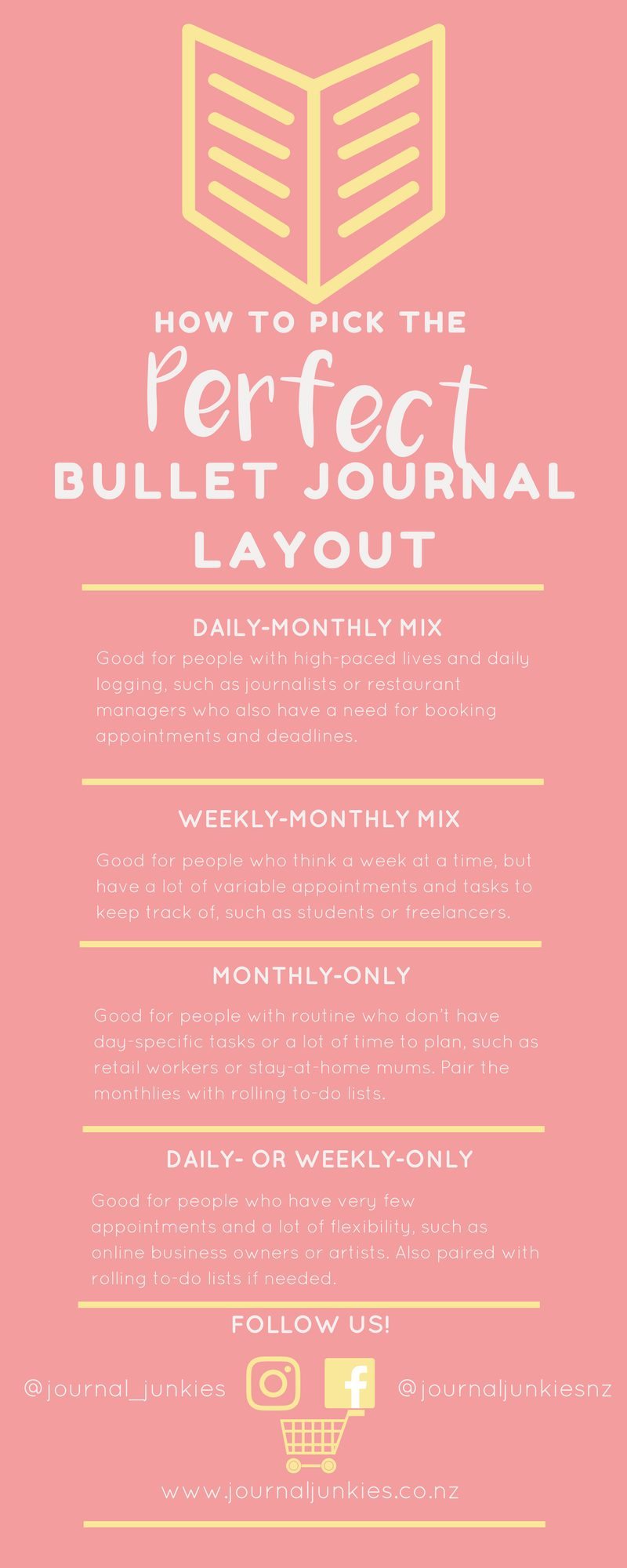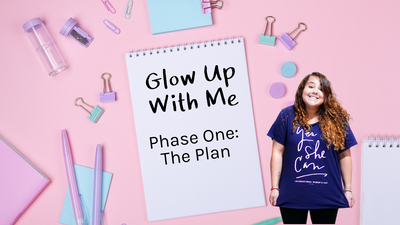"The road to freedom is a beautiful system."
This post is dedicated to all our lovely Journal Junkies who emailed asking for advice on picking the perfect layout combination.
It's the big Bullet Journal question - what spread, or spreads, should you be using?
Unfortunately, there is no "one-size-fits-all" answer.
The truth is, most of our favourite Bujo layouts (or layout combinations) took many attempts and tweaks to get just right. And a layout that works today, may not work tomorrow!
The key is to be open to trying new things and enjoying the process. If you don't, you may as well buy a normal diary and call it quits.
You may have heard that success doesn't happen overnight - it's the same with your systems. They take some thought, planning and a lot of trial and error.
If you're willing to really get involved in the organisation process, here are some things we wish we had thought about before starting.
*Click here to jump to the different spread combos*

How big is your handwriting?
In the world of note-taking, a centimetre can make all the difference.
Take a look at one of my earliest spreads. It used to drive me nuts that I was squishing my notes into these columns.
[caption id="attachment_485" align="alignright" width="300"]
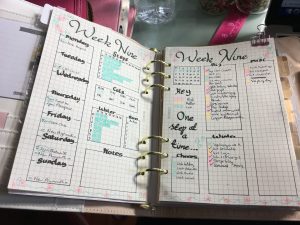 The Wellness Spread[/caption]
The Wellness Spread[/caption]While fitting more columns in seems tempting, ask yourself if it actually gives you enough space.
The narrower ones were fine for lists such as "Chores" or simple calendar entries. But not for more detailed lists.
So, instead of squeezing in my handwriting to fit it in the columns, I changed the columns to fit my handwriting.
"If something doesn't work, change it."
You should experiment with column/list sizes and see how much room you actually need - this all depends on what you're writing and how big your handwriting is.
Don't feel you should be replicating beautiful Bullet Journal spreads that don't work for you - that lack of restriction is part of the Bujo's beauty. Embrace it.
 How far in advance do you plan?
How far in advance do you plan?
When first starting out, we recommend people think about what fixed diaries or planners they used the most before Bullet Journaling.
Some people choose a day-a-page, some need half-hour appointment time-slots. Others just used a monthly wall calendar. Some hardly use a diary at all and just write task lists in a notebook or on sticky notes.

Whatever diary you were most comfortable with and used the most, is probably a good indication of what Bullet Journal spreads you will rely on.
Also think about how you used your diary - how far in advance did you tend to plan? Were you filling in appointments months ahead of time? Or usually not more than a week ahead? These are all factors which can help you decide what layout combinations are right for you.
Spread Combos
Are you task or appointment focused?
The big Bullet Journal question: What spread(s) do you use?
Luckily, my planner requirements have changed so much over the past few years that I've needed every mixture of spreads imaginable. And here's what I've discovered.
Daily-monthly mix
Good for: high-paced lives and daily logging, such as journalists or restaurant managers who also have a need for booking appointments and deadlines.
Dailies are great when you have a lot of on-the-go to-do lists.
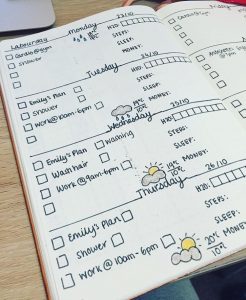
If you turn up to work not really knowing what you'll end up doing that day and your tasks come flooding in as the day progresses, which are required to be completed asap (a lot of high-paced jobs require this treadmill-style of working), then you want your to-do list to grow, and ultimately die (read: be completed) on the same day.
Dailies are also good for actual journalling, maybe writing down memories or logs such as food logs, because they allow you to use as much space as you need.
Dailies usually require minimal set up (just the date needs to be written down unless you're super fancy, but remember it just has to work) and are set up either the night before or the morning of - Does this fit into your current habits? Do you plan your day over your morning coffee, for example? If so, this could be just the system you need.
Want to track your time? Read more about time-ladders for Bullet Journalists here.
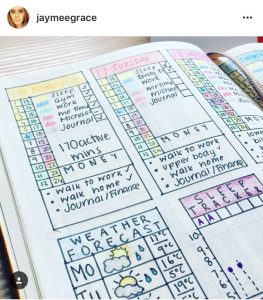 If you're worried about future appointments or deadlines, a detailed monthly should cover you here - If you're likely to have more than one appointment on any single day (not necessarily everyday), then you probably want to make room for that on your monthly.
If you're worried about future appointments or deadlines, a detailed monthly should cover you here - If you're likely to have more than one appointment on any single day (not necessarily everyday), then you probably want to make room for that on your monthly.One way of doing that is having space for morning, afternoon, evening appointments and a task column, too. Having this, as well as your future log, means you'll never miss a beat, even if you only work day-by-day.
Weekly-Monthly mix
Good for: people who think a week at a time, but have a lot of variable appointments and tasks to keep track of, such as students or freelancers.
If you usually gravitate towards week-per-view diaries, you will probably suit using a weekly.
Weeklies can be super variable, but the common denominators are that you can see all 5 or 7 days on one spread, and you set it up before the week starts.
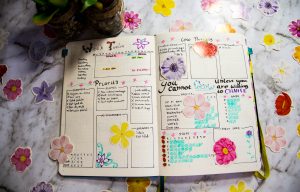
Think about what that means - can you put aside 30 mins on a weekend to plan the week ahead? If not, this might not be the system for you.
Remember, there is no right and wrong way of doing things - it's just got to work for you.
When planning your weekly, think about your ratio of appointments and day-specific tasks, and your to-do lists. Mentally split your allotted space into that ratio.
For example, your days might be a single 4cm-wide column, but your to-do lists get a whole page to themselves.
Other weeks, the whole two pages could be taken up by the days, because you have more day-specific tasks and appointments.
When I was juggling a lot of appointments, I accompanied my weeklies with detailed monthlies, which had space for morning, afternoon and evening appointments, as well as a space for tasks to be completed that week.

I had my monthlies set up three or four months ahead of time because of teaching and studying. It let me see which weeks were full of deadlines and events and where I could squeeze something else in. It was a lifesaver for conscious planning.
You can also put some trackers in your weekly if you have recurring daily tasks or habits you want to keep an eye on (such as working out or making the bed).
Side note: I love to seperate my to-do lists into categories, because my brain works on one subject at a time. You might have different school subjects, or maybe admin, errands and phone calls. It can help focus your time spent on tasks.
Read more: Make more space in your Bullet Journal Spreads with Dutch Doors
Monthly-only
Good for: People with routine who don't have day-specific tasks or a lot of time to plan, such as retail workers or stay-at-home mums. Pair the monthlies with rolling to-do lists.
A good monthly can work wonders if you're short on planning time.
If you're likely to have many recurring events (Swimming lessons every Wednesday) or don't need to plan for work (if you have seperate work systems, or work in retail or hospitality), setting up your Bullet Journal just once-a-month might be perfect - and a notebook will also last you a lot longer, bonus!
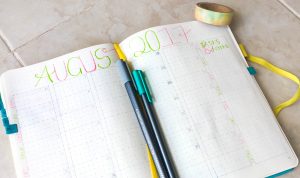
For a lot of people, they have habitual systems in place for a lot of their lives. You might not need to write down a reminder to pack your kid's swim bag on a Tuesday night or wash your bedding at the weekend - so don't.
What you do need to remember, though, is breaks in the routine. A monthly layout, not unlike a standard calendar, with space for a to-do list (or you could have pages of rolling to-do lists - more on that later) might be all you need to remember to buy so-and-so's birthday gift next week and your shift change to 3pm on Saturday.
A monthly habit tracker can be a nice addition to the monthly set-up and don't forget a future log to keep track of appointments or events planned more than a month ahead of time (such as Weddings and holidays).
Daily- or Weekly-only
Good for: (Same as above but broken into smaller chunks.) People who have very few appointments and a lot of flexibility, such as online business owners or artists. Also paired with rolling to-do lists if needed.
If you don't have a lot of appointments but endless to-do lists (without many deadlines), then there's no need for a monthly spread but it relies on a future log that works for you.
As long as your future log can accomodate your lifestyle, you'll have space to note down your dentist appointment next month as well as adding "update stock" to your to-do list.

Pro tip: Use tiny colour-coded marks or acronyms for recurring events in your future log, such as classes or publishing days .
If your life is very flexible and task-oriented, this might be all you need. Choose between daily and weekly logs, based on when and how you plan (day-by-day vs week-by-week).
Also consider using a weekly-habit tracker over a monthly if you're this-way inclined. You're more likely to stick with it if you re-evaluate it every week.
Rolling to-do lists or Project pages
When you don't have many appointments or deadlined-tasks, stick to a simple monthly layout with project pages.
For example, at the moment I'm spending the morning on one website, the afternoon on another and my personal time on another.

So, I just have a spread for each of them that are just lists of things I need to do, and I just chip away at them (and add follow-up tasks or ideas) during their allotted time.
This way, I don't get distracted by off-topic tasks that need to be done and I don't keep moving tasks from one spread to another.
These project pages can be useful no matter what your calendar layout choice is. You could have one for spring cleaning and decluttering your house, for example.
Conclusion
Picking the perfect Bullet Journal layout can take a lot of experimenting. As your life changes, your planning needs do, too.
But this is exactly why the Bullet Journal system work, because it can change when you do. You're not stuck to that weekly view that doesn't have enough space for tasks or moving from one notebook to the other just to find your project's to-do list.
But it you think about what you really need to get out of your Bullet Journal, it'll help you tailor your spreads to your own life.
Note on Pinterest-worthy Spreads: Sure, all those Bullet Journal pages on Instagram and Pinterest are beautiful. And some of them have really cool ideas for organising your life. But please realise that there's no point in your pages being beautiful if it's not helping you get organised. The Bullet Journal system doesn't rely on coloured pens or special notebooks. It relies on you using it to its full potential.
